A new type of energy has been discovered, and some individuals—known as “catalysts”—have the ability to tap into that energy, bringing fame and fortune to their cities.
What Is Catalyst?
Catalyst is a card-combo game from dV Giochi for 2 to 4 players, ages 10 and up, and takes about 20 to 40 minutes to play. It retails for about $28 ($25 Euros) and is available from Amazon, in game stores, or directly from dV Giochi. There’s a sci-fi theme, but the game is largely abstracted; I think 10 and up seems about right based on the complexity of the game.
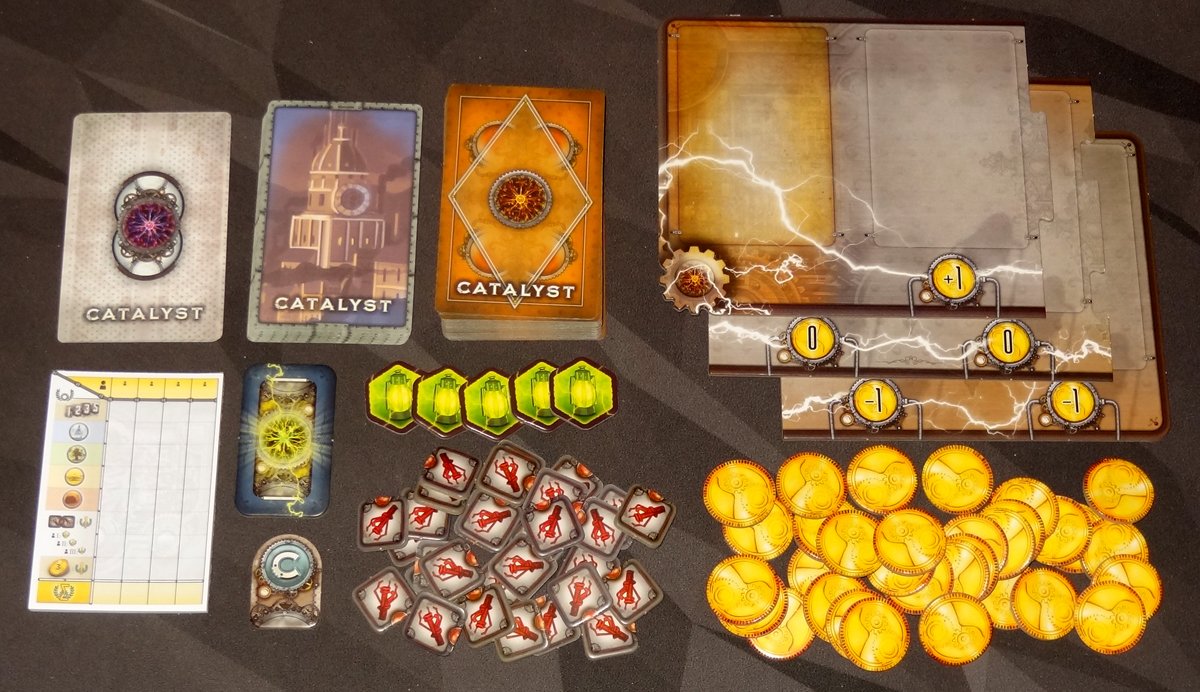
Catalyst Components
Here’s what comes in the box:
- 60 Catalyst cards
- 16 Building cards
- 4 Goal cards
- Game board
- 32 Coins
- 30 Military Power tokens
- 5 Chain Activation tokens
- 1 Final Round token
- 1 Starting Player marker
- 1 scoring pad
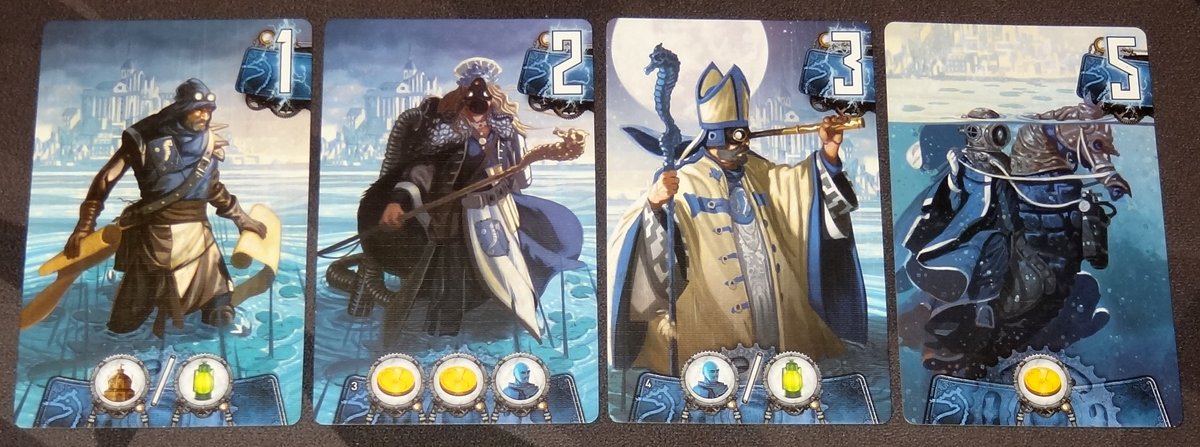
The cards are all large, tarot-sized cards with a nice linen finish. They look lovely, and have some great artwork on them (by Yann Tisseron), but there’s not actually that much gameplay information on them: a numerical value in the top corner, a faction color, and some number of action icons at the bottom. Everything else is just purely decorative, though I really enjoy the wacky character designs. (My favorite is probably the blue 5, which depicts a person in a deep-sea-diver mask riding a giant armored seahorse.) I think the game itself could have been made with smaller cards and would function just the same, but I do enjoy the look of the game. (I wouldn’t say no to a pocket-sized version of the game, though!)
The catalyst cards come in four different colors, representing four different factions; there’s some iconography at the top corner and bottom left that help distinguish factions even if you’re color blind. Catalysts are valued 1, 2, 3, and 5, with only one 5 in each faction.

The tokens are all nice cardboard punch-outs, and the board itself is made of three pieces that fit together, puzzle-style (also punched out). Because of the way the plastic insert was designed, you’ll want to hang onto leftover cardboard and tuck it under the insert so that things don’t shift around. It’s a nice, small square box size—fairly compact, without too much wasted space (other than the extra thickness for the cardboard sheets).

I’ve had some players with a few quibbles about the font choices in the game. The “2” and “5” are angular and kind of similar, and some players viewing them upside-down got them reversed. Also, the “0” on the main board, because they’re tall and narrow, have often been mistaken for an outlined “1” at first (until players also see the “+1” and “-1”). It doesn’t take a lot to note that when teaching the game, but it’s a mistake that many first-time players have made.

How to Play Catalyst
You can download a copy of the rulebook here.
The Goal
The goal of the game is to score the most points by activating catalysts, amassing military power, and fulfilling the goals on the goal card.

Setup
Lay out the board in the center of the table. Sort the buildings into face-up stacks according to their colors, arranged in increasing value (with the “1” on top), next to the board. Place the coins, chain activation tokens, and military power tokens in a supply near the board. Shuffle the goal cards and choose one at random, placing it face-up near the board. Return the other goal cards to the box.
Choose a starting player and give that player the start player token. Give players gold based on their turn order: 4/5/5/6 gold.
Sort the deck of catalyst cards: some cards have a tiny “3” or “4” at the bottom left—you only use these cards if you have at least that many players. Remove any unneeded cards and put them back into the box, then shuffle the rest. Set aside 10 cards (face-down) and place the final round token on this stack. Place the rest of the deck on the board in the space provided, and then flip over the top 5 cards into the available spaces.

Gameplay
On your turn, you take one of these three actions: Collect Contributions, Recruit a Catalyst, or Activate a Catalyst.
Collect Contributions
Take gold from the supply equal to the highest-value catalyst card on the board.
Recruit a Catalyst
Pay gold to the supply to take a catalyst from the board and place it in front of you. The cost is the large number on the catalyst card, modified by the value printed below its space on the board. The card closest to the deck costs 1 more than its face value; the two cards farthest from the deck each cost 1 less than their face value.
If you have any empty buildings in front of you, a newly recruited catalyst must immediately be placed in an empty building. Once placed, catalysts may not be moved to another building, and each building may only hold one catalyst.
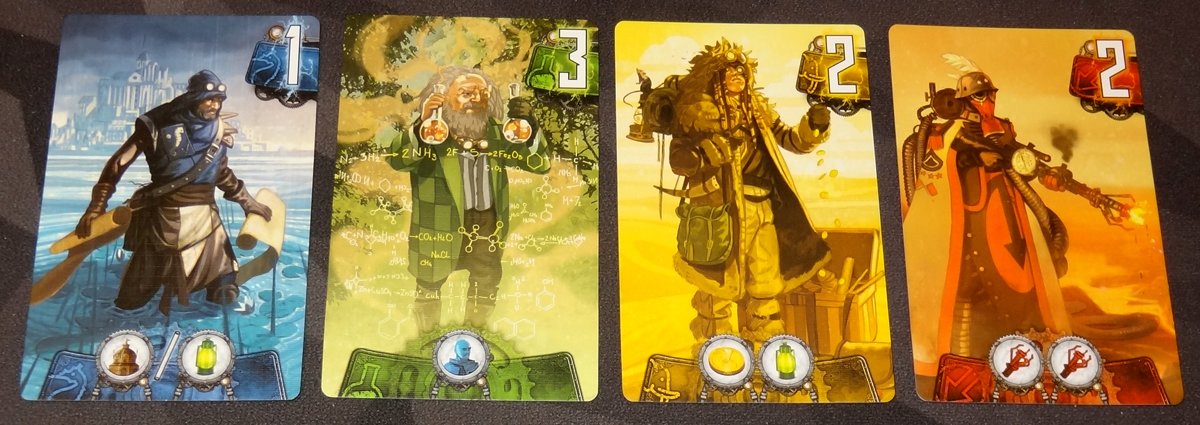
Activate a Catalyst
Choose a catalyst in front of you to activate: turn the card sideways, and then you may use any of its ability icons in any order (at the bottom of the card). Then, if the catalyst is in a building, you may also activate the building’s ability.
The abilities are as follows:
- Take a coin from the supply.
- Recruit a catalyst (paying the cost as usual).
- Take 1 chain activation token.
- Take 1 military power token.
- Acquire 1 building.
A slash indicates that you choose one of the effects; if there is no slash, you may use all of the effects as desired.
Chain Activation Tokens
Chain activation tokens may be spent to activate an additional catalyst during the same turn. These tokens may not be saved for future turns, so you use it or lose it.
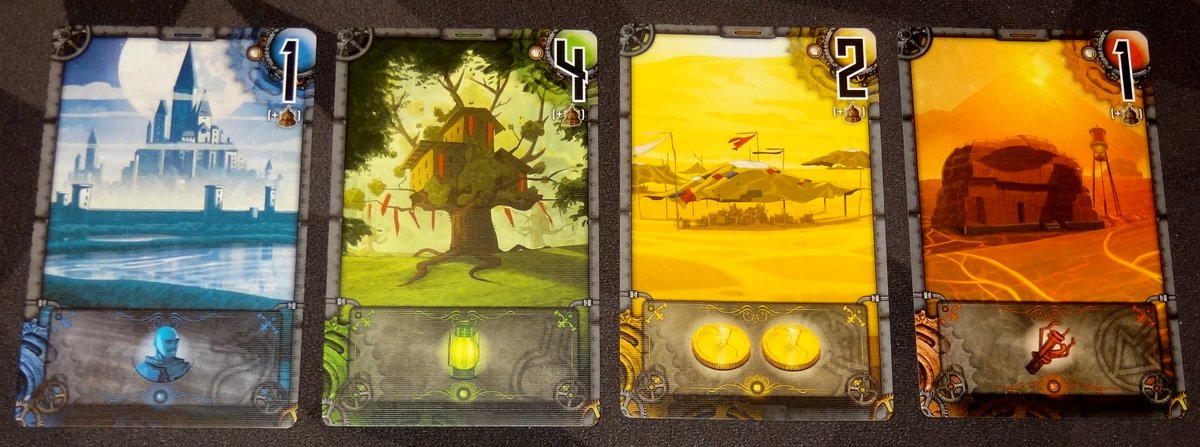
Buildings
There are four types of buildings, one for each color, with similar abilities as the catalysts. You may only have one of each color. The buildings increase in price as you go through the stack, so the earlier you buy a building, the cheaper it will be. The score value of a building depends on the goal card (explained below). Buildings do not go into your scoring pile after they’re used—they stay on the table, and you put newly recruited catalysts into them.
End of Turn
At the end of your turn, you slide cards on the board to the right to fill in empty spaces, and then refill the board from the deck. You also must discard down to 8 coins if you have more. Finally, any catalysts you activated are now placed face-down in your scoring pile. (At this time, if you have remaining catalysts and empty buildings, you place your catalysts into your buildings as space allows.)
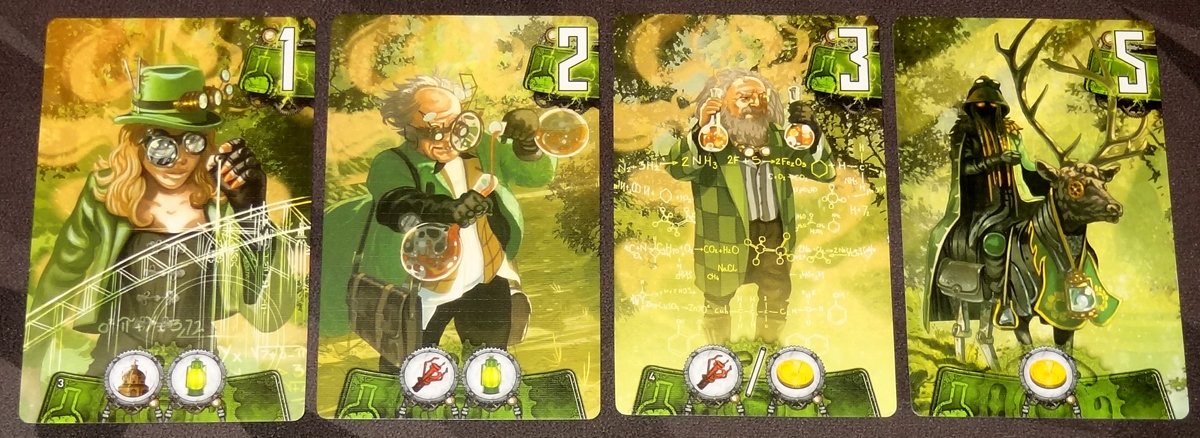
Game End
When you run out of the deck of catalyst cards, set aside the Final Round token and start using the set-aside stack of cards. Finish the current round, and then play one more final round (so that all players have had the same total number of turns). Then the game ends.

Total up your victory points:
- Catalysts in your score pile are worth their face value. (Catalysts that have not yet been activated are not worth any points.)
- Gold is worth 1 point for every 3 coins.
- Military power is worth 1 point for every 2 tokens. Also, the player with the most gets 6 points, second most gets 3 points, and third most gets 1 point.
- Score points for your building based on the goal card.

Each goal card shows the four building types, and indicates how they score. Some buildings may simply be worth a number of points. Others will award points based on catalysts that you have in your scoring pile: 2-value catalysts, blue catalysts, catalysts that have a “military power” symbol at the bottom, and so on. Catalysts in your scoring pile may count toward multiple building goals.

Why You Should Play Catalyst
Catalyst is a quick-playing game that’s all about card combinations and making the most efficient use of your single available action each turn. While it may seem strange to call it an engine-building game because each catalyst is only used once, the buildings stick around and allow you to link actions together. I suppose it’s more of a chain-building game: you build up a chain of catalysts, trigger them, and then build back up again. Figuring out the best combination of catalysts and buildings is an entertaining puzzle.
Thematically, the game is a little thin: there’s an introductory story about catalysts, and you have a vague sense of the four factions: yellow merchants in the desert earn money, green steampunk chemists activate other catalysts, red warriors in the … red desert?… build up military might, and blue underwater royalty help you recruit more catalysts. That’s not true of every card in each faction, but it’s the general sense. But there’s not really any other story—you don’t really know much about any of these catalysts, or the world they live in. Why do the chemists look like munchkins from Oz? Do the blue catalysts live in the water, or just travel through the water to get to shore? Are those warriors even on the same planet? None of those questions are answered, nor do you really know why any given building is worth points for certain criteria.
That said, I didn’t mind at all: the gameplay is quick and light, and only needs a little hint of flavor. You could just as easily have used numbered cards without any theme at all, but the artwork gives you something nice to look at. I also would have been fine with regular-sized cards, since you could easily fit the game-relevant information onto smaller cards and still have them be easily legible. But, again, I do like the fantastical illustrations, and the tarot-sized cards showcase them well. If you’re looking for a game that plays out a narrative or has a bit more immersion in the theme, though, you may be disappointed.

Here’s an example of chaining together several actions in a single turn. In the photo above, I have three catalysts, each in a building. Here’s how I could play this out, activating them from left to right:
- Activate the yellow 2 catalyst to gain 3 coins. Then activate the green building for a chain activation token.
- Spend the chain activation token to activate the green 1 catalyst, which allows me to buy a building and get a chain activation token. I buy a red building, since I don’t have one yet, using the coins I just received. Then activate the yellow building to gain 2 coins.
- Spend my second chain activation token to activate the green 2 catalyst, giving me 1 coin and a chain activation token. Then activate the blue building, which allows me to recruit a catalyst. I use the remaining coins to recruit a catalyst, which goes into my empty red building.
- I use my third chain activation token to activate my newly recruited catalyst (whatever it does), and then activate the red building to gain a military power token.
This turn allowed me to gain my fourth building and put 4 catalysts into my scoring pile. Of course, the first three catalysts are all fairly low-value, but if the goal card rewards me for green catalysts, or chain activation symbols, or 2-value catalysts, then I may have scored a few bonus points there. Also, it’ll take me some time to fill up my four empty buildings now, but if I use the blue building (and also recruit catalysts that have the recruit icon on them), I could fill them up more quickly.
I feel like there’s a bit of a juggling act between the recruit/coins/activation icons: you need a combination of all three in order to do more than one thing on a turn. If you have a recruit action, you also need money. If you have both of those but not a chain activation, then the newly hired catalyst can’t be activated until the next turn. If you can get chain activation tokens but you don’t have any more catalysts, then those benefits were wasted. Figuring out how to set things up so that you can set them all off in a single turn is always great, because it saves you some extra turns.
The military power action is a little more disconnected, and often gets overlooked, because military power is simply going for points, and doesn’t contribute to your engine at all. Building up military can be a lot of points (plus the bonus 6 points for having the most), but it doesn’t help you get money, recruit more catalysts, or get buildings, so a lot of players don’t pursue it aggressively. Once you see somebody start taking military power, however, you have to decide if you want to compete with them, or try to find your points elsewhere.
With only one action per turn (barring chain activation tokens), you have to make your choices carefully. If there’s a 5-value catalyst on the board, it may be a great time to collect some money—but sometimes that can feel like throwing away a turn, if other players are recruiting or chaining together catalysts.
Early in the game, everyone’s hoping that the “buy building” action will show up in the marketplace when it’s their turn to recruit. The 1-value catalysts have this “buy building” action (sometimes paired with other effects), and there are enough for everyone to get their 4 buildings. Of course, the sooner you get them, the more often you’ll get to use the building effects, so those catalysts tend to get snatched up right away. Sometimes, it may be worth taking money or activating a catalyst instead of recruiting, simply to decrease the chances that you’ll reveal a 1-value catalyst for the next player. (And, of course, there’s the tactic of buying up the 1-value catalysts even when you already have four buildings simply to deny your opponents the chance to buy buildings for themselves.) The game can suffer a little from feeling like you’ve had bad luck with what shows up in the market, but part of the game is figuring out what to do with what’s in front of you.

Ideally, you get all four buildings by the end of the game, and are also able to meet the requirements for the various goals so that each building scores points. But sometimes you can’t count on getting all four buildings, so then you have to decide which ones to pursue. That may be based on which building action you want to use the most, or it may be based on which building will be worth the most points based on catalysts that you already have in your scoring pile. It’s important to keep an eye on the goal card so that you can take that into account as you recruit catalysts and buy buildings.
Hiring the 5-value catalysts is expensive, but that’s 5 points (as long as you activate them before the game ends). They don’t do much other than give you 1 coin, but if you can afford them, they may be worth as many points as a building. Also, the longer the 5-value catalyst sits in the marketplace, the more everyone can collect 5 coins on their turn. Buying them reduces everyone’s income.
Overall, I’ve really enjoyed Catalyst, and I recommend it for players who like card combos and figuring out puzzles. It’s been pretty easy to teach, plays quickly, and has been a hit with most the gamers I’ve introduced it to. It’s a fairly light game and the theme is kind of pasted on, but I found the gameplay engaging enough that the artwork and theme are just the icing on the cake.
Click here to see all our tabletop game reviews.
![]() To subscribe to GeekDad’s tabletop gaming coverage, please copy this link and add it to your RSS reader.
To subscribe to GeekDad’s tabletop gaming coverage, please copy this link and add it to your RSS reader.
Disclosure: GeekDad received a copy of this game for review purposes.






